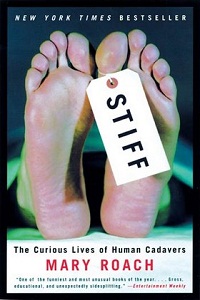Stiff by Mary Roach Post-It Assignment
Stiff: The Curious Lives of Human Cadavers
Alternative Assignment
- Stiff by Mary Roach; Chapter questions and essay assignment
I. Introduction
You have probably read many fiction books and are familiar with the format of these stories, they usually have a character development, plot, antagonists, and a clear beginning, middle and end. Nonfiction text is often limited to academic textbooks or news articles. By reading, Mary Roach's nonfiction book "Stiff", you will gain an appreciation for text that is not a story, but is still engaging, contains scientific themes and provides new information and insights into the use of cadavers for research.
Reading nonfiction is not exactly the same as reading fiction, as there is rarely a clear beginning, middle and end. Many nonfiction books are divided into chapters that highlight specific areas of the author's research or insights.
Read this blog article: "How to Read a Nonfiction Book" and you will see that the author suggests many strategies, including skipping around and reading chapters he find most interesting. As you read "Stiff" you will employ a strategy using Post-It notes to help organize, remember, and summarize the author's message and information.\
II. Active Reading
As you read the chapters in Stiff, attach a post-it note to pages where you highlight something interesting. You should have 4-10 Post-It's per chapter, use the following symbol guide to create your notes. Stiff has 12 chapters, you are only required to map (Post-It) 8 of those chapters. You are welcome to read them all, of course, but you can also choose to focus on chapters that interest you the most or skip those you do not find interesting. You may wish to skim the chapters or browse the table of contents.
Each Post-It will contain three items
1. Symbol (see chart)
2. Page and paragraph number
3. Content
Symbol |
Content on Post-It |
| Star |
An insightful statement, or quotation, an attention grabber; what makes it stand out |
| Question Mark |
A statement, sentence or even a word that you are uncertain about; include your own guess as to its meaning |
| Test Tube |
Where the scientific method is highlighted in order to solve a problem; in your own words summarize or create a mini-outline |
Thought Bubble |
An opinion regarding a statement in the text (the statement can also be an opinion the author holds that you agree or disagree with |
| Plus symbol |
Summarize a large section of the text, or event that occurred in the book |
Target symbol |
A thesis statement, or topic statement about the chapter or content, something that seems very important or poignant |
| Arrow symbol |
Make a prediction about what is going to come next, or where the author is going with a particular sentence or paragraph |
Sample of Text with Post-IT
Here is an excerpt from Stiff
The heads are for plastic surgeons, two per head, to practice on.... "Isolate the brow as a skin island." The [instructor] speaks slowly, in a flat tone. I'm sure the idea is to sound neither excited and delighted at the prospect of isolating skin islands, nor overly dismayed. The net effect is that he sounds chemically sedated, which seems to me like a good idea.
Source: http://www.maryroach.net/stiffExcerpts.html
A Post-It In this section may look like this:
The post-its can then be removed and glued or taped to construction paper to turn in.
III. Final Product
When you are finished, remove all of your post-it notes from the book (check to be sure you have page numbers listed). You will then place these post its on notebook or plain white paper. No more than 6 post-its per page and you will need to reinforce them with tape or glue so that none of them get lost.
These pages will be used in a timed writing exercise in class and turned in to your instructor for credit.
IV. Timed Writing
Resources: Timed Writing: Techniques for Success - http://www.collegeboard.com/student/plan/boost-your-skills/50269.html
Sample Timed Writing Essay:
What are the potential benefits and drawbacks of surgeons using cadavers to practice new surgical techniques?
